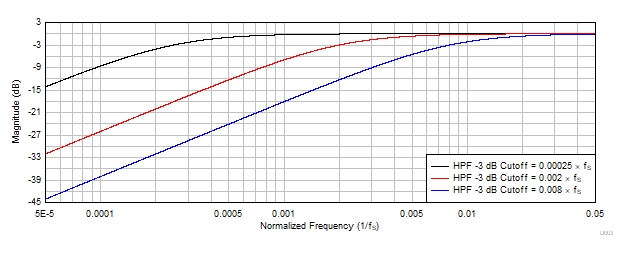SLASFC1 December 2023 TAD5212
ADVANCE INFORMATION
- 1
- 1 Features
- 2 Applications
- 3 Description
- 4 Revision History
- 5 Pin Configuration and Functions
-
6 Specifications
- 6.1 Absolute Maximum Ratings
- 6.2 ESD Ratings
- 6.3 Recommended Operating Conditions
- 6.4 Thermal Information
- 6.5 Electrical Characteristics
- 6.6 Timing Requirements: I2C Interface
- 6.7 Switching Characteristics: I2C Interface
- 6.8 Timing Requirements: SPI Interface
- 6.9 Switching Characteristics: SPI Interface
- 6.10 Timing Requirements: TDM, I2S or LJ Interface
- 6.11 Switching Characteristics: TDM, I2S or LJ Interface
-
7 Detailed Description
- 7.1 Overview
- 7.2 Functional Block Diagram
- 7.3
Feature Description
- 7.3.1
Serial Interfaces
- 7.3.1.1 Control Serial Interfaces
- 7.3.1.2 Audio Serial Interfaces
- 7.3.1.3 Using Multiple Devices With Shared Buses
- 7.3.1.4 Phase-Locked Loop (PLL) and Clock Generation
- 7.3.1.5 Output Channel Configurations
- 7.3.1.6 Reference Voltage
- 7.3.1.7 Programmable Microphone Bias
- 7.3.1.8
Signal-Chain Processing
- 7.3.1.8.1
DAC Signal-Chain
- 7.3.1.8.1.1 Programmable Channel Gain and Digital Volume Control
- 7.3.1.8.1.2 Programmable Channel Gain Calibration
- 7.3.1.8.1.3 Programmable Digital High-Pass Filter
- 7.3.1.8.1.4 Programmable Digital Biquad Filters
- 7.3.1.8.1.5 Programmable Digital Mixer
- 7.3.1.8.1.6
Configurable Digital Interpolation Filters
- 7.3.1.8.1.6.1
Linear Phase Filters
- 7.3.1.8.1.6.1.1 Sampling Rate: 16 kHz or 14.7 kHz
- 7.3.1.8.1.6.1.2 Sampling Rate: 24 kHz or 22.05 kHz
- 7.3.1.8.1.6.1.3 Sampling Rate: 32 kHz or 29.4 kHz
- 7.3.1.8.1.6.1.4 Sampling Rate: 48 kHz or 44.1 kHz
- 7.3.1.8.1.6.1.5 Sampling Rate: 96 kHz or 88.2 kHz
- 7.3.1.8.1.6.1.6 Sampling Rate: 384 kHz or 352.8 kHz
- 7.3.1.8.1.6.1
Linear Phase Filters
- 7.3.1.8.1
DAC Signal-Chain
- 7.3.1.9 Interrupts, Status, and Digital I/O Pin Multiplexing
- 7.3.1
Serial Interfaces
- 7.4 Device Functional Modes
- 7.5 Register Maps
- 8 Application and Implementation
- 9 Power Supply Recommendations
- 10Device and Documentation Support
- 11Mechanical, Packaging, and Orderable Information
Package Options
Mechanical Data (Package|Pins)
- RGE|24
Thermal pad, mechanical data (Package|Pins)
- RGE|24
Orderable Information
7.3.1.8.1.3 Programmable Digital High-Pass Filter
To remove the DC offset component and attenuate the undesired low-frequency noise content in the record data, the device supports a programmable high-pass filter (HPF). The HPF is not a channel-independent filter setting but is globally applicable for all DAC channels. This HPF is constructed using the first-order infinite impulse response (IIR) filter, and is efficient enough to filter out possible DC components of the signal. Table 7-14 shows the predefined –3-dB cutoff frequencies available that can be set by using the DAC_DSP_HPF_SEL[1:0] register bits of P0_R115. Additionally, to achieve a custom –3-dB cutoff frequency for a specific application, the device also allows the first-order IIR filter coefficients to be programmed when the DAC_DSP_HPF_SEL[1:0] register bits are set to 2'b00. Figure 7-16 illustrates a frequency response plot for the HPF filter.
| P0_R115_D[5:4] : DAC_DSP_HPF_SEL[1:0] | -3-dB CUTOFF FREQUENCY SETTING | -3-dB CUTOFF FREQUENCY AT 16-kHz SAMPLE RATE | -3-dB
CUTOFF FREQUENCY AT 48-kHz SAMPLE RATE |
|---|---|---|---|
| 00 | Programmable 1st-order IIR filter | Programmable 1st-order IIR filter | Programmable 1st-order IIR filter |
| 01 (default) | 0.00002 × fS | 0.25 Hz | 1 Hz |
| 10 | 0.00025 × fS | 4 Hz | 12 Hz |
| 11 | 0.002 × fS | 32 Hz | 96 Hz |
 Figure 7-16 HPF
Filter Frequency Response Plot
Figure 7-16 HPF
Filter Frequency Response PlotEquation 1 gives the transfer function for the first-order programable IIR filter:

The frequency response for this first-order programmable IIR filter with default coefficients is flat at a gain of 0 dB (all-pass filter). The host device can override the frequency response by programming the IIR coefficients in Table 7-15 to achieve the desired frequency response for high-pass filtering or any other desired filtering. If DAC_DSP_HPF_SEL[1:0] are set to 2'b00, the host device must write these coefficients values for the desired frequency response before powering-up any DAC channel for playback. Table 7-15 shows the filter coefficients for the first-order IIR filter.
| FILTER | FILTER COEFFICIENT | DEFAULT COEFFICIENT VALUE | COEFFICIENT REGISTER MAPPING |
|---|---|---|---|
| Programmable 1st-order IIR filter (can be allocated to HPF or any other desired filter) | N0 | 0x7FFFFFFF | P17_R120-R124 |
| N1 | 0x00000000 | P17_R125-R128 | |
| D1 | 0x00000000 | P18_R8-R11 |